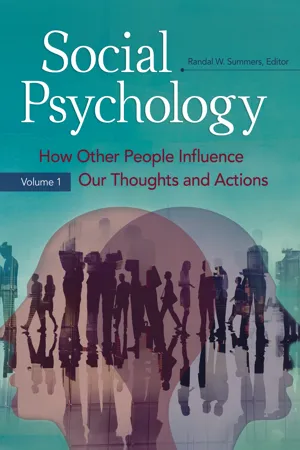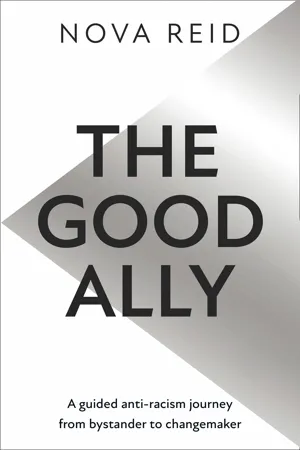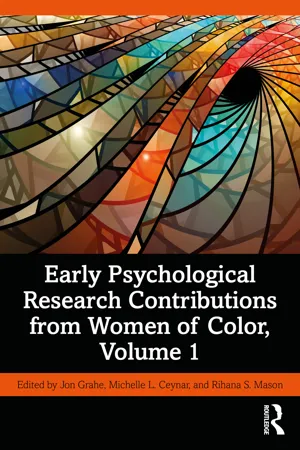Psychology
Hughes Policeman Doll Study
The Hughes Policeman Doll Study was conducted by psychologist Kenneth B. Clark and his wife Mamie P. Clark in the 1940s. The study involved presenting African American children with black and white dolls and asking them to express their preferences. The findings revealed that the children showed a preference for the white dolls, highlighting the impact of racial segregation and discrimination on the self-esteem and identity of African American children.
Written by Perlego with AI-assistance
Related key terms
Related key terms
1 of 4
Related key terms
1 of 3
3 Key excerpts on "Hughes Policeman Doll Study"
- eBook - ePub
Social Psychology
How Other People Influence Our Thoughts and Actions [2 volumes]
- Randal W. Summers, Randal W. Summers, Randal W. Summers(Authors)
- 2016(Publication Date)
- Greenwood(Publisher)
Classic Experiments in Social Psychology 1939–1940s—Clark Doll Experiment, Mamie Phipps Clark and Kenneth Bancroft ClarkThe doll experiment was first conducted as part of Mamie Phipps Clark’s master’s thesis in 1939 at Howard University. In 1950 Mamie Phipps Clark and her husband Kenneth Bancroft Clark repeated the experiments across the country with 300 children. The Clarks were looking at how racial stereotypes can become ingrained in the self-esteem of racially segregated schoolchildren. They used two identical dolls, except one was dark colored and one was white colored. The children were African Americans between the ages of six and nine and were asked a number of questions about the dolls, like which one they liked more, which one was bad, which one was nice, which one they would rather play with, or which one looks like them, and so on. The results indicated that 44 percent of the black children said the white doll looked like them. In addition, students of these segregated schools were more likely to pick the white doll as the nice one. The Clarks, who were African American, found in one study, involving 16 black children from Clarendon County, South Carolina, that 63 percent of them chose the white doll as the nice one and the one they wanted to play with. This study became the highlight of the testimony presented to the Supreme Court in the case of Brown v. Board . The court ruled to end racial segregation.Further ReadingAhuja, G. “What a doll tells us about race.” ABC News, March 31, 2009. Retrieved from http://abcnews.go.com/GMA/story?id=7213714&page=1 .Columbia University Libraries. “Mamie Clark.” Notable New Yorkers, 2006. Retrieved from www.columbia.edu/cu/lweb/digital/collections/nny/clarkm .Proulx, M. G. “Professor revisits Clark doll tests.” The Harvard Crimson, 2011. Retrieved from www.thecrimson.com/article/2011/12/1/clark-dolls-research-media - eBook - ePub
- Nova Reid(Author)
- 2021(Publication Date)
- HQ(Publisher)
1In a 1985 PBS TV interview called ‘Eyes on the Prize’, Dr Kenneth Clark recalled that the majority of African American children who took part in the study would often reject the Black doll and when told to show the doll that most looked like them, many became incredibly distraught, and even left the room when they realised they identified with the doll they had just rejected.2These psychological tests not only expose the self-hate and internalised racism some Black children experience, but also how widespread anti-Blackness – and indeed, colourism – are. Both anti-Blackness and colourism are by-products of white supremacy and a painfully revealing example of how damaging racism is to children.The results from the Clark Doll Project were astonishing, but perhaps unsurprising. This study and the Clarks’s testimonies played a monumental role in the 1954 Brown vs Board of Education Topeka Supreme Court case which proved that systemic racism in schools was widespread and that prejudice, discrimination and segregation were negatively and psychologically impacting children. Findings like these led to the abolishment of segregation in schools in the US. It was ruled unanimously that segregation promoted a feeling of unworthiness and, in the words of Dr Kenneth Clark, a feeling ‘some Black children may never get over… These children saw themselves as inferior and they accepted the inferiority as part of reality.’3 - Jon Grahe, Michelle Ceynar, Rihana S. Mason, Jon Grahe, Michelle Ceynar, Rihana S. Mason(Authors)
- 2023(Publication Date)
- Routledge(Publisher)
Clark, 1944 , p. i).The Clarks are most known for the work she did for her master's thesis and several follow-up studies they completed together, now known as the “doll studies.” These studies presented African American children with two dolls that were identical except for their skin and hair color: white (with yellow hair) or brown (with black hair). The children answered questions about the dolls such as which was prettier, nicer, and looked “bad.” While 66% of the children correctly indicated that the brown-skinned doll was more like them, 59% said the white-skinned doll was “nice” and 67% preferred to play with the white-skinned doll. The results indicated internalized prejudice (Clark & Clark, 1939 ; Jones & Pettigrew, 2005 ). This landmark work was cited as evidence in the U.S. Supreme Court case Brown v. Board of Education of Topeka, Kansas and helped end school segregation (Guthrie, 2004 ; Jones & Pettigrew, 2005 ). During the case, Phipps Clark and her dissertation advisor Garrett both testified, but on different sides (Williams, 1987 ). The Court concluded, “To separate them [students of color] from others of similar age and qualifications solely because of their race generates a feeling of inferiority as to their status in the community that may affect their hearts and minds in a way unlikely ever to be undone” (see Guthrie, 2004 ). The “separate but equal” policy was now illegal.While Phipps Clark held various positions after earning her doctorate, she expressed frustration at finding one worthy of her qualifications. “It soon became apparent to me that a Black female with a Ph.D. in psychology was an unwanted anomaly” (see O’Connell & Russo, 2001 , p. 271). She overcame this challenge by becoming the executive director and co-founder (along with her husband) of the Northside Center for Child Development in Harlem (she kept this position until her retirement in 1979; Guthrie, 2004 ), helping the next generation in a direct way. Originally, she hoped to change the White-oriented educational and social services systems she had encountered in her childhood and in New York City, but she found their racism too entrenched (Markowitz, 2021 ). Instead, the Northside Center provided direct services for inner-city children such as mental health counseling, intelligence testing, drug rehabilitation, and community psychiatry (Markowitz & Rosner, 1996 ). The Center also organized community activism around political and social issues such as educational reform, housing reform, and better relations among distinct minority groups (such as Black-Jewish relations in the city). “Northside was a microcosm of the world the Clarks desired: a world of social equality, humanity, integration, and caring for all children and their families, without regard to race and circumstance” (Markowitz, 2021 ). It employed social workers, counselors, psychiatrists, teachers, caseworkers, pediatricians, and researchers all devoted to helping children thrive, sometimes working for free (Lal, 2002 ; Markowitz & Rosner, 1996
Index pages curate the most relevant extracts from our library of academic textbooks. They’ve been created using an in-house natural language model (NLM), each adding context and meaning to key research topics.
Explore more topic indexes
Explore more topic indexes
1 of 6
Explore more topic indexes
1 of 4


